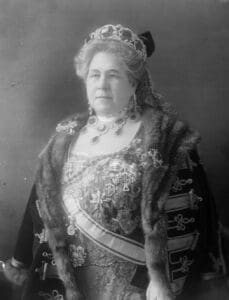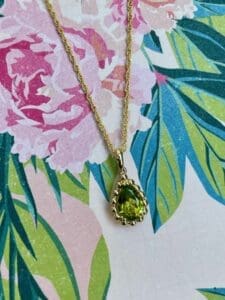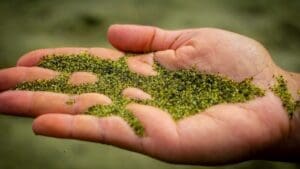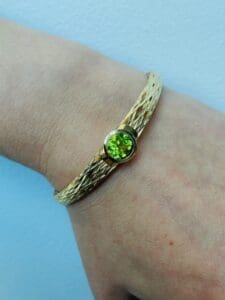Found in outer space, raining from volcano eruptions, and a gift from Napoleon, Peridot is absolutely fascinating! Though a somewhat less recognized gem, you will become captivated by this August birthstone with these facts about Peridot and its’ rich history.
1. Etymology & Geology
– French, derived from Arabic, faridhat (‘gemstone’)
– Hebrew Bible, “Pitdah”, the Second Stone in High Priest Aaron’s Breastplate, one source for the list of Gemstones by Month[1]
GEOLOGY:
– Gemstone quality of the mineral Olivine, also called or grouped in with Chrysolite.
– While most gemstones form in the Earth’s Crust, Peridot is the only gemstone, along with Diamond, to occur in the Upper Mantle. Deposits are found in igneous rocks such as basalt and gabbro. Owing to their similar tectonic origins, Peridot is considered a trace gemstone in prospecting for diamond mines.
– Compositional elements include Iron, Magnesium and Silicon, often occurring in the igneous conditions from which Peridot forms. One of the few gemstones to present in one color – a broad range of yellow-brown-green hues – Peridot’s ideal bright olive-green derives from exactly 15% Iron. Higher concentrations take on darker brown traces while lower amounts are fainter.
– One of few gemstones to be found in outer space, with samples procured in 2006 by NASA Explorer’s Stardust program dated to be 4.6 million years old.
– Peridot is the first gemstone to be found on Mars, notably in a 19,000 mile stretch of Olivine. [2]
– Meteorites and Pallasites have been found with Peridot pockets. One of only a few jewelry-quality and quantity hordes crashed in Russia in 1749.
2. History
– First sourced in Egypt’s Topazios Island (also known as Zabargad or St. John’s) in the Red Sea, as referenced by Pliny the Elder. The original mines have been depleted since their 1906 rediscovery.[3]
– Known as the “Evening Emerald and “The Gem of The Sun”, was consumed in Egyptian beverages to imbibe with its light, has often adorned religious jewelry and relics, such as Catholic Bishops’ Peridot-and-Amethyst Rings.
– Associated with Pele, the Hawaiian Volcano Goddess, manifesting in the volcanic glass Pele’s Hair and the green sand beaches (three out of four worldwide are in Hawaii). Owing to these prominent connections, Peridot is sometimes known as Hawaiite.[4]

https://www.geologyin.com/2014/11/the-green-sand-beach-mahana-beach.html
– Napoleon is said to have given Josephine a Peridot for eternal love (despite their eventual divorce for want of an heir). Peridot was also his birthstone and green his favorite color.
http://www.peridot.com/blog/napoleon-broooch-peridot-diamonds-20280/
– Has endured surge and slump periods since the 19th Century, becoming the favorite gemstone of King Edward VII[5] during its Victorian and Edwardian-Era heights. Another bump was spurred in the 1990’s by a large finding in Pakistan.
3. Notable Examples
– Largest Cut Peridot: 311.80 carats | Origin: Zabargad Island | Ownership and Provenance: Smithsonian Institution, Washington A. Roebling Collection (gem collector, civil engineer, son of Brooklyn Bridge architect John Roebling).[6] Other Smithsonian holdings include a 286.60 cttw from Myanmar, as well as 110.66 cttw and 103.25 cttws of unknown origin.[7]
– Cologne Cathedrals’ Shrine of The Magi featured 200-carat Peridots, once thought to be Emeralds.
– Hapsburg Peridot Parure, fashioned in 1820 by Court Jeweler Kochert. Auctioned in 2001 by Sotheby’s London to Fred Leighton, who loaned to Joan Rivers for the 2004 Golden Globe Awards. The collection has been sold separately since its 2006 purchase by philanthropist Lily Safra.[8]

– In 2018, Hawaii’s Kilauea Volcano went viral for its “raining green” peridot crystals that were extruded during eruption, despite most being too small or fractured to be gem quality.[9]
4. Industry & Practices
– Moh’s Hardness Scale: 6.5-7/10
– Prone to weathering, Peridot is rarely found in samples larger than four carats and is best worn in jewelry that meets less wear and tear, such as earrings and pendants.
– Heat treatment are not needed to balance color, and some jewelers even recommend against purchasing heated Peridot. Some oil or resin-rubs – similarly used with Emeralds – are applied to strengthen fissures and brighten luster, but these should be identified in gemology and purchasing reports.
– Soft scrubs and gentle detergents advised for brief cleaning. Ultrasonic and Steam Cleaners are too strong
– Arizona’s Peridot Mesa on the San Carlos Apache Reservation is the world’s largest current mining site for Peridot. Other prominent deposits are found in New Mexico and abroad in Myanmar, Pakistan, Vietnam, South Africa, and China[10]
Special thanks to our Sales Associate, Annique, who meticulously researched and documented endless information to create these fact about Peridot. Stop in to pay her a visit, or send a quick e-mail, to learn even more!
References:
[1] https://www.biblestudy.org/bible-study-by-topic/gemstones-in-the-bible/peridot.html
[2] https://www.igi.org/the-gemstones-of-mars-are-coming/
[3] https://agta.org/education/gemstones/peridot/
[4] https://www.gemstones.com/gemopedia/peridot
[5] https://www.tatler.com/gallery/tatlers-jewellery-editor-choose-peridot-this-months-eye-catching-birthstone
[6] https://dalesjewelers.com/blog/2020/08/03/worlds-largest-faceted-peridot-and-the-brooklyn-bridge-have-this-in-common/
[7] https://naturalhistory.si.edu/explore/collections/geogallery/10002808
[8] https://royalwatcherblog.com/2021/09/05/habsburg-peridot-parure/
[9] https://www.rockngem.com/peridot-crystals/
[10] https://agta.org/education/gemstones/peridot/








